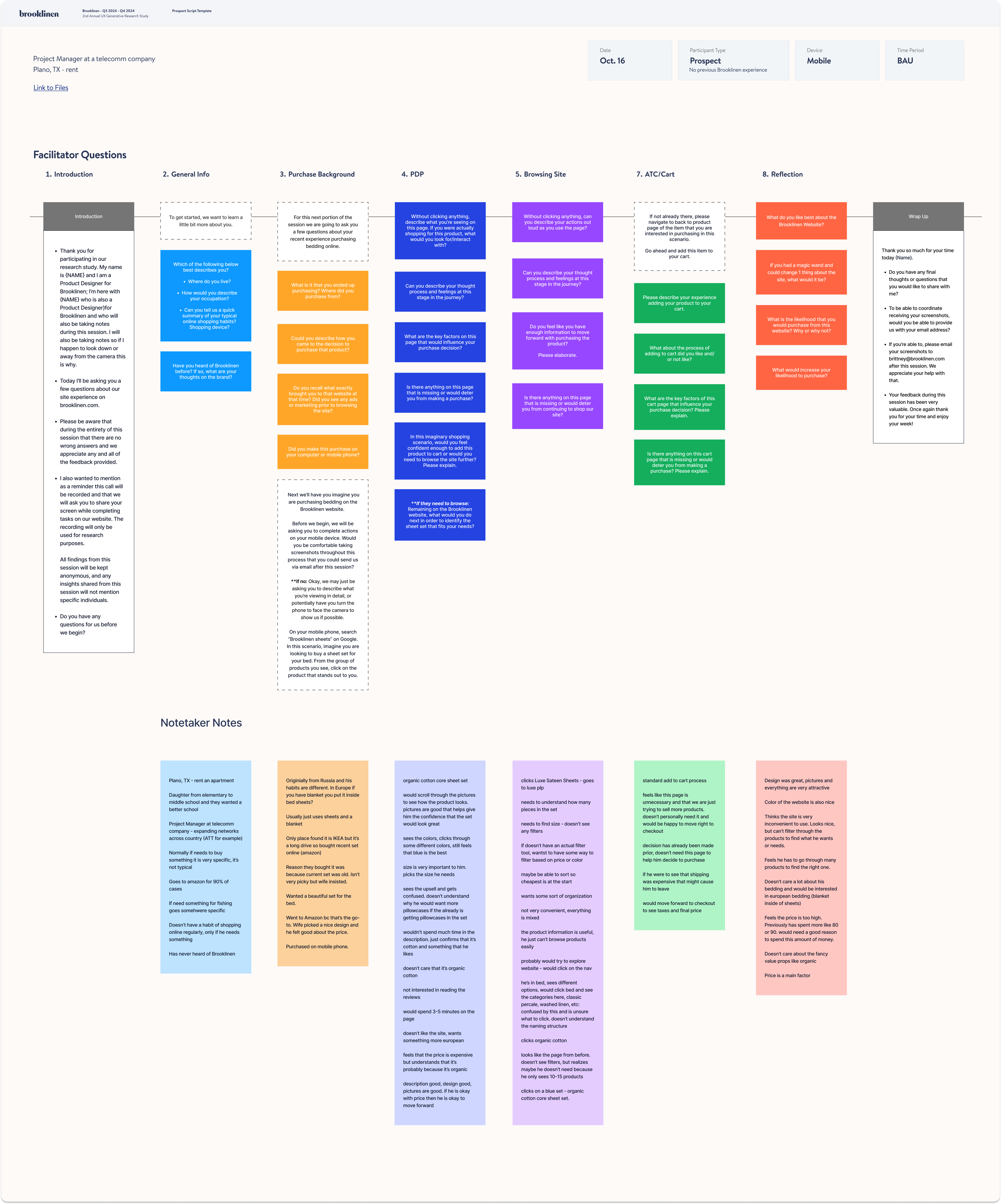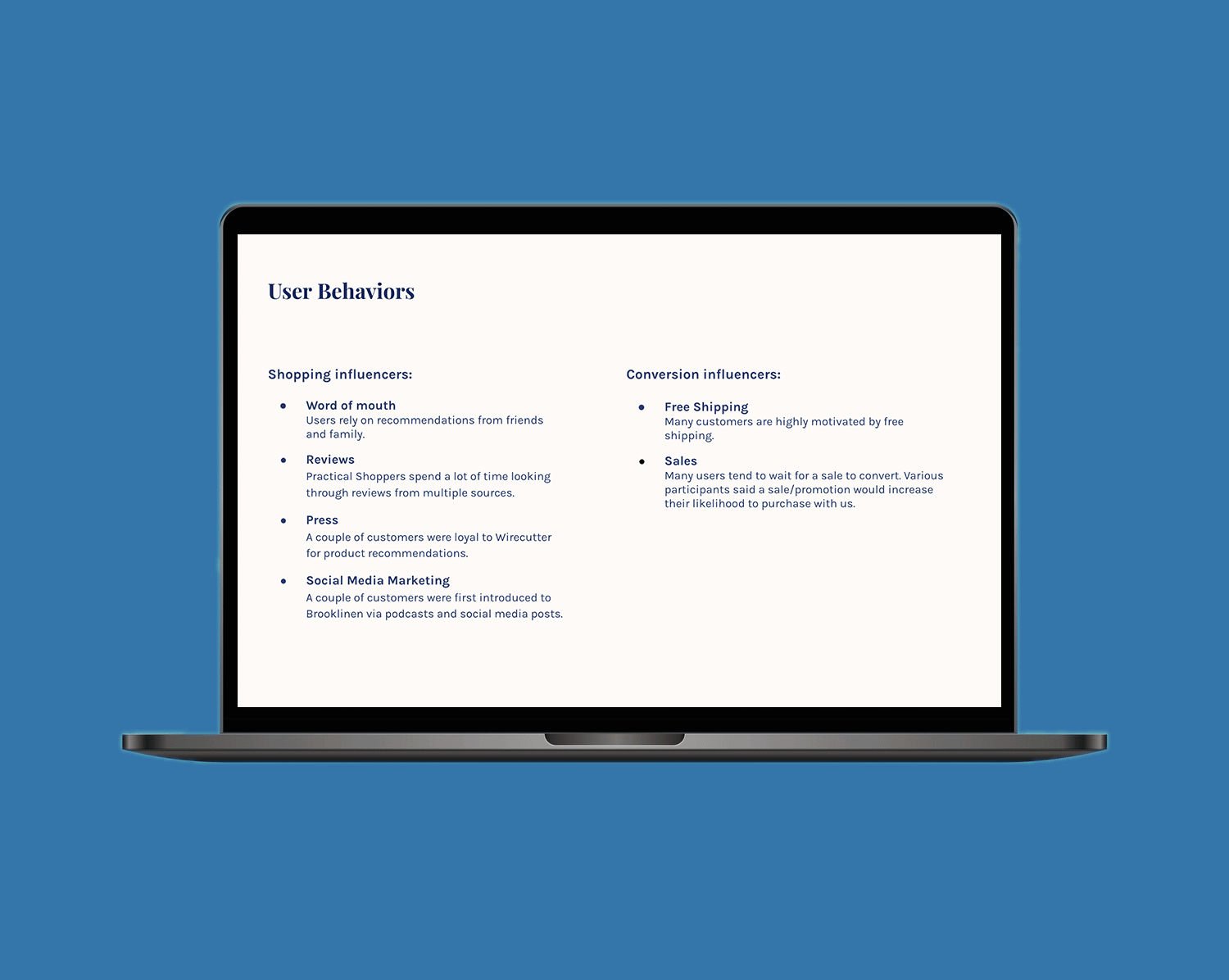Brooklinen: Generative User Research Study 2024
2024-2025
test plan, interview script, moderated interviews, affinity mapping, experience mapping, analysis shareout
team credits:
Katie Schirmann

PROJECT OVERVIEW
My colleague and I were tasked with conducting the 2nd annual comprehensive generative user research study of Brooklinen.com. The main goal of this research study was identifying new actionable user problems to solve for within the site journey and analyzing any shifts in findings from the previous year’s study. To begin, we prepared a test plan that explained our goals, research method, tools, recruitment plan, analysis, and reporting.
My colleague and I were tasked with conducting the 2nd annual comprehensive generative user research study of Brooklinen.com. The main goal of this research study was identifying new actionable user problems to solve for within the site journey and analyzing any shifts in findings from the previous year’s study. To begin, we prepared a test plan that explained our goals, research method, tools, recruitment plan, analysis, and reporting.
TEST PLAN

INTERVIEW SCRIPT
After aligning with leadership stakeholders on our high level plan, we needed to craft a unique set of interview scripts that would guide each of our fully moderated Zoom user interviews. While we did hope to receive usability feedback and insights on the entire site experience, we were asked to focus on the optimization of our PLP (collection pages) conversion, add to cart rate, and cart to checkout initiatives.
![]()
After aligning with leadership stakeholders on our high level plan, we needed to craft a unique set of interview scripts that would guide each of our fully moderated Zoom user interviews. While we did hope to receive usability feedback and insights on the entire site experience, we were asked to focus on the optimization of our PLP (collection pages) conversion, add to cart rate, and cart to checkout initiatives.

CONDUCTING INTERVIEWS
30 Moderated 45min Zoom Interviews
1 Facilitator + 1 Note Taker
My colleague and I took turns as the facilitator and note taker of each interview. To analyze patterns in user behavior based on device type, we had half of our participants complete a shopping journey on a desktop and half on their mobile phone. We verbally guided each user through a scenario of shopping for bed sheets and used our script to ask questions and make observations of their behaviors along the way.
![]()
ANALYSIS: AFFINITY MAPPING
After each user interview, we compiled the raw notes written into stickies that could later be aggregated and grouped as emerging themes within the affinity mapping process. The stickies shown below are just a small sample of the hundreds of stickies we grouped by hand to craft our key insights presentation.
![]()
By collecting and synthesizing the qualitative data this way, we were able to identify the most prominent user problems; many of which gave us immediate ideas for how to improve a certain feature or experience within the website.
![]()
ANALYSIS: EXPERIENCE MAP
This helped to pinpoint where along the user journey our research study participants were having the most trouble. It also resulted in a brainstorm for potential solutions to these specific user concerns.
![]()
PRESENTATION TO EXECUTIVE LEADERSHIP
Once we finalized our analysis, we began designing our presentation to share the outcome of our research study with our executive leadership team. We started by dropping our long list of identified user problems, desires, behaviors and themes into a google doc to share with our digital product team leaders. We went through all 30 Zoom recordings and edited clips that aligned with the UX themes we wanted to highlight. Finally, we refined a selection of the most impactful and easily actionable insights into our presentation deck.
![]()
TURNING LEARNINGS INTO SOLUTIONS
presentation --> brainstorm --> UX initiatves added to ecomm roadmap
I am very proud of all of the hard work that went into making this research study a massive success. Doing this foundational user research allowed my team and I to make informed recommendations on stakeholder UX/UI requests and ideas going forward. We constantly leverage the Baymard Institute’s robust library of UX case study research, but actual generative user feedback was crucial in getting user-centered initiatives added to our department’s roadmap.
30 Moderated 45min Zoom Interviews
1 Facilitator + 1 Note Taker
My colleague and I took turns as the facilitator and note taker of each interview. To analyze patterns in user behavior based on device type, we had half of our participants complete a shopping journey on a desktop and half on their mobile phone. We verbally guided each user through a scenario of shopping for bed sheets and used our script to ask questions and make observations of their behaviors along the way.

ANALYSIS: AFFINITY MAPPING
After each user interview, we compiled the raw notes written into stickies that could later be aggregated and grouped as emerging themes within the affinity mapping process. The stickies shown below are just a small sample of the hundreds of stickies we grouped by hand to craft our key insights presentation.

By collecting and synthesizing the qualitative data this way, we were able to identify the most prominent user problems; many of which gave us immediate ideas for how to improve a certain feature or experience within the website.

ANALYSIS: EXPERIENCE MAP
This helped to pinpoint where along the user journey our research study participants were having the most trouble. It also resulted in a brainstorm for potential solutions to these specific user concerns.

PRESENTATION TO EXECUTIVE LEADERSHIP
Once we finalized our analysis, we began designing our presentation to share the outcome of our research study with our executive leadership team. We started by dropping our long list of identified user problems, desires, behaviors and themes into a google doc to share with our digital product team leaders. We went through all 30 Zoom recordings and edited clips that aligned with the UX themes we wanted to highlight. Finally, we refined a selection of the most impactful and easily actionable insights into our presentation deck.

TURNING LEARNINGS INTO SOLUTIONS
presentation --> brainstorm --> UX initiatves added to ecomm roadmap
I am very proud of all of the hard work that went into making this research study a massive success. Doing this foundational user research allowed my team and I to make informed recommendations on stakeholder UX/UI requests and ideas going forward. We constantly leverage the Baymard Institute’s robust library of UX case study research, but actual generative user feedback was crucial in getting user-centered initiatives added to our department’s roadmap.